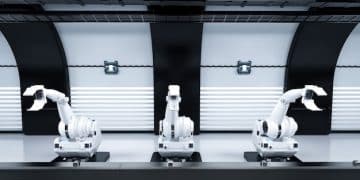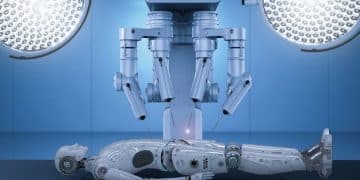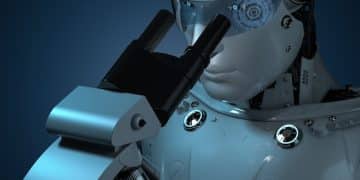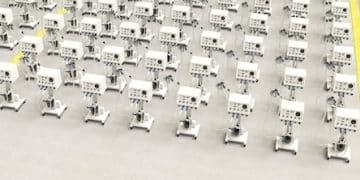US Robotics Startups: Disrupting Industry with Innovative Solutions
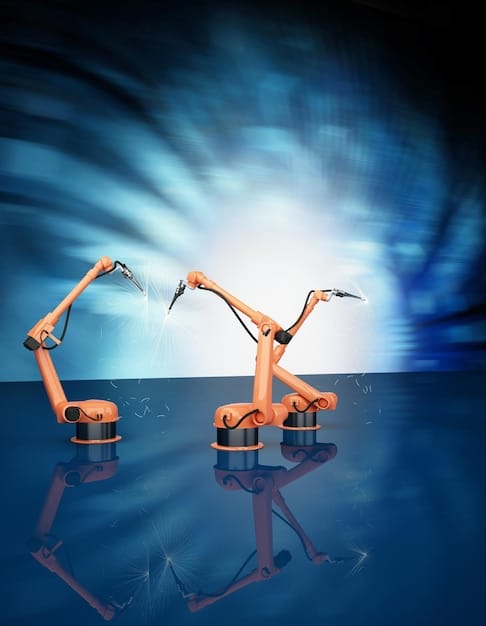
The US robotics landscape is currently experiencing a dynamic period of innovation, with numerous startups introducing groundbreaking solutions that are revolutionizing industries from manufacturing to healthcare and logistics, fundamentally reshaping traditional operational paradigms.
The landscape of technological innovation is continuously reshaped by emerging companies that dare to challenge the status quo. In the United States, a vibrant ecosystem of robotics startups is pushing boundaries, pioneering solutions that promise to redefine fundamental aspects of various sectors. Identifying which companies are truly making waves and delivering US Robotics Startups: Which Companies Are Disrupting the Industry with Innovative Solutions? requires a deep dive into their core technologies, market impact, and disruptive potential.
The resurgence of robotics and the US innovation hub
The United States has long been a hotbed for technological advancement, and robotics is no exception. Recent years have seen a significant resurgence in investment and research within the sector, fueled by advancements in artificial intelligence, machine learning, and sensor technologies. This fertile ground has allowed numerous startups to flourish, each bringing unique perspectives and solutions to complex problems.
The historical trajectory of US innovation provides a robust framework for understanding the current boom in robotics. Decades of research in academic institutions and government labs laid the groundwork, fostering a culture of scientific inquiry and engineering excellence. This foundational strength, combined with a dynamic venture capital market and a spirit of entrepreneurialism, creates an unparalleled environment for robotic innovation. Furthermore, the diverse industrial needs across the vast US economy offer myriad opportunities for niche and broad applications of robotic technologies.
This surge isn’t merely about incremental improvements; it’s about fundamental shifts in how tasks are performed, from intricate surgical procedures to large-scale agricultural operations. The integration of advanced perception systems, dexterous manipulators, and complex decision-making algorithms is enabling robots to undertake roles that were once exclusively human domains. The collaborative nature of many university and industry partnerships further accelerates this progress, ensuring that theoretical breakthroughs are quickly translated into practical, deployable systems. This blend of strong foundational research, robust investment, and diverse application needs positions the US at the forefront of the global robotics revolution.
Key trends driving innovation in US robotics
Several overarching trends are shaping the current wave of innovation within US robotics startups. Understanding these trends is crucial for appreciating the broader impact of these emerging technologies. The drive towards automation is no longer confined to traditional industrial settings; it is permeating every aspect of daily life and commerce, supported by technological breakthroughs.
Automation beyond manufacturing
While manufacturing has traditionally been the primary adopter of robotics, the current trend sees automation extending into logistics, healthcare, agriculture, and even retail. Startups are developing robots for tasks like last-mile delivery, surgical assistance, crop harvesting, and customer service, demonstrating a remarkable versatility. This expansion is driven by various factors, including labor shortages, the demand for increased efficiency, and the need for enhanced safety in hazardous environments. The cost-effectiveness of these solutions is also improving, making them accessible to a wider range of industries beyond large-scale industrial operations. The development of more adaptable and user-friendly robotic systems further facilitates this integration into diverse sectors, moving beyond the traditional caged robots of the past.
AI and machine learning integration
Modern robotics is heavily reliant on advanced artificial intelligence and machine learning algorithms. These technologies enable robots to perceive their environment, learn from experience, make informed decisions, and adapt to unforeseen circumstances. From sophisticated navigation systems for autonomous vehicles to object recognition for robotic manipulation, AI is the brain behind the brawn. The ability for robots to learn and improve over time, often through neural networks and deep learning, represents a significant leap forward. This integration allows for unprecedented levels of autonomy and intelligence, moving robots beyond programmed, repetitive tasks to dynamic, responsive interaction with complex, unstructured environments.
Human-robot collaboration (cobots)
The concept of collaborative robots, or cobots, is gaining significant traction. These robots are designed to work alongside humans, augmenting their capabilities rather than replacing them entirely. Cobots are typically smaller, more flexible, and equipped with advanced safety features that allow them to operate in shared workspaces without the need for extensive guarding. This trend facilitates a synergistic relationship where humans contribute their cognitive skills and adaptability, while robots handle repetitive, strenuous, or precise tasks. It’s about enhancing human potential through technology, creating more efficient and safer workplaces. The ease of programming and adaptability of cobots are also key factors in their growing adoption, especially in small and medium-sized enterprises.
Miniaturization and modularity
Robots are becoming smaller, more agile, and more adaptable. Miniaturization allows for deployment in confined spaces or for delicate tasks, while modularity enables customization and rapid deployment for specific applications. This trend makes robotics more accessible and versatile, opening up new possibilities for innovation in fields like micro-surgery and personal robotics. The ability to quickly reconfigure robotic systems using modular components significantly reduces development time and costs, fostering a more agile and responsive approach to robotic design and deployment.
Spotlight on pioneering US robotics startups
Dozens of innovative companies are making significant contributions to the US robotics landscape. While an exhaustive list is impossible, here are a few examples showcasing the breadth and depth of disruption. These companies represent diverse applications and technological approaches, each pushing the boundaries of what is possible with robotic technology. Their successes, and occasional failures, collectively define the cutting edge of the industry.
Agility Robotics: The future of human-centric tasks
Agility Robotics, based in Oregon, is renowned for its bipedal robot, Digit. Unlike wheeled or tracked robots, Digit is designed to navigate human-centric environments, making it ideal for tasks in logistics, warehousing, and last-mile delivery. The robot’s human-like form factor allows it to seamlessly integrate into existing infrastructure not designed for traditional robots. Its ability to walk, stoop, and carry packages makes it a versatile solution for automating tasks in spaces built for people.
* Key innovations:
* Bipedal locomotion for human-centric environments
* Advanced perception and navigation for unstructured spaces
* Designed for deployment in logistics and delivery
* Disruptive potential: Addresses the significant labor challenges in warehousing and delivery by providing an autonomous, mobile solution that can work alongside human employees. Their approach simplifies the integration of automation into existing facilities, potentially bypassing the need for extensive infrastructure overhauls.
Agility’s focus on bipedal design stems from the realization that most human environments are optimized for upright locomotion. By eschewing wheels or tracks that require flat surfaces, Digit can operate effectively in varied terrains, climb stairs, and navigate tight corridors. This makes them particularly appealing for logistics operations that involve navigating complex indoor and outdoor environments. The company’s vision extends beyond mere package movement, aiming to create a general-purpose robotic workhorse capable of performing a multitude of physical tasks in diverse settings.
Boston Dynamics: Redefining mobility and dexterity
While not strictly a “startup” in the traditional sense, Boston Dynamics remains a crucial player, having evolved from an MIT spin-off into a global leader in advanced robotics. Known for its highly dynamic and agile robots like Spot (a dog-like robot) and Atlas (a humanoid), Boston Dynamics has consistently pushed the boundaries of robotic mobility, balance, and manipulation. Their work continues to be foundational in inspiring new robotic applications.
* Key innovations:
* Dynamic balancing and locomotion in challenging terrains
* Advanced manipulation capabilities for complex tasks
* Robots designed for inspection, public safety, and hazardous environments
* Disruptive potential: Their robots, particularly Spot, are being deployed in diverse fields from construction site inspection to remote public safety monitoring, demonstrating the utility of highly mobile and resilient robotic platforms in real-world, unpredictable conditions.
Boston Dynamics’ emphasis on extreme mobility and robust design sets them apart. Their robots are engineered to withstand demanding environments and perform tasks that are difficult or dangerous for humans. This capability opens up applications in critical infrastructure inspection, disaster response, and situations requiring presence in hazardous zones. The company’s long history of innovation and relentless pursuit of advanced robotic capabilities ensures its continued influence on the industry.
Locus Robotics: Revolutionizing warehouse automation
Locus Robotics offers autonomous mobile robots (AMRs) specifically designed for warehouse fulfillment. Their LocusBots work collaboratively with human pickers to optimize order fulfillment processes, significantly increasing productivity and accuracy. The system is highly scalable and flexible, adapting to varying order volumes and warehouse layouts.
* Key innovations:
* Optimized AMRs for e-commerce and retail fulfillment
* Collaborative human-robot workflow
* Cloud-based software for real-time optimization
* Disruptive potential: By improving warehouse efficiency and reducing labor costs, Locus Robotics is enabling e-commerce companies to meet ever-increasing demands for faster and more accurate deliveries, which is critical in today’s competitive retail landscape.
The beauty of Locus Robotics’ solution lies in its ability to enhance existing human labor rather than replacing it entirely. Their AMRs handle the strenuous and time-consuming tasks of navigating vast warehouses, bringing items directly to the pickers. This allows human workers to focus on the more nuanced task of picking and packing, leading to a significant boost in overall productivity and a reduction in ergonomic strain. The flexibility of their system also means warehouses can adapt to peak seasons and fluctuating demands without massive capital expenditures.
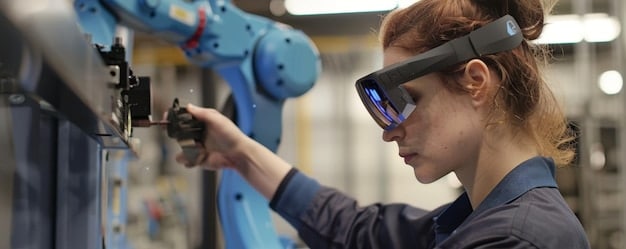
Emerging sectors and specialized applications
Beyond the major players, numerous smaller startups are carving out niches in specialized sectors, demonstrating the vast potential of robotics to address specific industry challenges. These companies often leverage cutting-edge research to develop highly tailored solutions, proving that disruption comes in many forms. They target areas where traditional automation has been slow to penetrate, or where unique problems require novel robotic approaches.
Healthcare robotics: Precision and care
The healthcare sector is witnessing a surge in robotics applications, from surgical assistance to patient care and rehabilitation. Startups are developing robots capable of performing minimally invasive surgeries, delivering medication, assisting with physical therapy, and even sanitizing hospital environments. The precision, consistency, and tireless nature of robots offer significant benefits in a field where errors can have dire consequences and demands for precision are paramount.
* Vicarious Surgical: Developing a highly miniaturized surgical robot that offers enhanced visualization and maneuverability, allowing for complex minimally invasive procedures through a single incision.
* Diligent Robotics: Creators of Moxi, a mobile robot designed to assist nurses with routine tasks like fetching supplies, freeing up human staff to focus on direct patient care.
These innovations address critical issues like surgeon fatigue, consistency of care, and labor shortages in healthcare settings. The ability of robots to operate with sub-millimeter precision opens up new possibilities for surgical techniques, reducing patient recovery times and improving outcomes. Beyond the operating room, tasks like patient transport and material handling can be automated, enhancing efficiency and allowing medical professionals to dedicate more time to clinical duties.
Agriculture robotics: Feeding the future
Farming is inherently labor-intensive and susceptible to environmental variability. Robotics is offering solutions to increase efficiency, reduce waste, and improve sustainability in agriculture. Startups are developing robots for automated planting, precision spraying, selective harvesting, and crop monitoring, leading to more efficient and environmentally friendly farming practices.
* Blue River Technology (acquired by John Deere): Revolutionized precision agriculture with computer vision and machine learning that allows tractors to spray only weeds, significantly reducing herbicide use.
* Abundant Robotics (now defunct, but pioneered the concept of apple harvesting robots): Developed robotic systems for automated fruit picking, demonstrating the feasibility of automating delicate harvesting tasks. While they faced challenges, their work laid important groundwork.
Agricultural robots promise to address labor shortages in the farming sector, which are becoming increasingly severe. They also enable precision farming, where resources like water, fertilizer, and pesticides are applied only where needed, reducing environmental impact and input costs. The ability to monitor individual plants and react to their specific needs could lead to higher yields and healthier crops, fundamentally transforming food production.
Logistics and fulfillment: Speed and scale
The explosion of e-commerce has put immense pressure on logistics and warehousing operations. Robotics startups are providing solutions to automate various aspects of fulfillment, from receiving and inventory management to picking, packing, and sorting. These solutions are crucial for meeting consumer expectations for fast and accurate deliveries. Companies that can scale their operations efficiently often rely heavily on these robotic integrations.
* RightHand Robotics: Develops versatile robotic picking systems that use advanced computer vision and dexterous grippers to handle a wide variety of items for order fulfillment. Their “RightPick” system can pick and place individual items into orders with high accuracy and speed.
* Symbotic: Offers an innovative AI-powered logistics platform that uses mobile robots to move, store, and retrieve products in warehouses, creating highly dense and efficient automated storage and retrieval systems.
These companies are directly responding to the increasing consumer demand for rapid delivery and the need for significant operational efficiency in the supply chain. By automating large portions of the warehouse workload, they help businesses manage vast inventories, process orders quickly, and cope with variable demand, especially during peak shopping seasons. The precision and tireless nature of robots also minimize errors, leading to higher customer satisfaction.
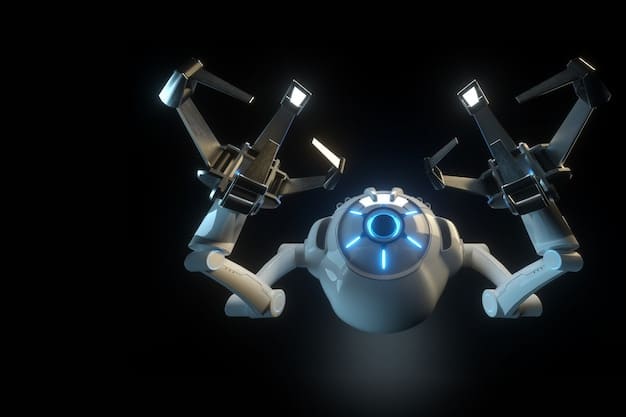
Challenges and the path forward for US robotics startups
Despite the immense promise, US robotics startups face a unique set of challenges as they strive to bring their innovations to market and scale their operations. Understanding these hurdles is essential for a complete picture of the industry’s trajectory. These challenges are not insurmountable but require strategic planning, significant investment, and an adaptable approach to development and deployment.
High development costs and capital intensity
Developing advanced robotic systems is inherently expensive. It requires significant investment in research and development, specialized hardware components, sophisticated software engineering, and rigorous testing. This high capital intensity often necessitates substantial venture capital funding, making it harder for early-stage startups to initially secure the required resources unless their value proposition is exceptionally strong. The journey from prototype to commercially viable product is long and expensive.
Talent acquisition and retention
The demand for skilled robotics engineers, AI specialists, and experienced integrators significantly outstrips supply. Startups must compete with established tech giants and other emerging industries for top talent. Attracting and retaining these highly sought-after professionals is a continuous challenge, often involving competitive compensation packages and stimulating work environments. The scarcity of specialized talent can hinder development timelines and limit scalability.
Regulatory and ethical considerations
As robots become more autonomous and integrated into society, regulatory and ethical concerns come to the forefront. Issues such as safety standards for human-robot interaction, data privacy, accountability in autonomous decision-making, and the societal impact of automation (e.g., job displacement) are complex and evolving. Startups must navigate a rapidly changing regulatory landscape, which can sometimes be slow to adapt to new technologies, potentially delaying market entry or requiring costly design modifications.
Market adoption and integration complexities
Even with groundbreaking technology, widespread market adoption can be slow. Integrating robots into existing workflows often requires significant changes to infrastructure, processes, and employee training. Businesses may be hesitant to invest in new technologies without clear, quantifiable returns on investment. Startups must not only demonstrate technical prowess but also prove the economic viability and ease of integration of their solutions. Educating potential clients and showcasing successful case studies are crucial for overcoming this hurdle.
The path forward for these startups involves continuous innovation, strategic partnerships, and a keen understanding of both technological and market dynamics. Collaborative efforts between academia, industry, and government could help address some of these challenges, fostering an environment where innovation can truly flourish and where the benefits of robotics are broadly realized across the economy and society. The ability to adapt to changing market needs and iterate on products quickly will be key for long-term success.
| Key Point | Brief Description |
|---|---|
| 🤖 Industry Disruption | US robotics startups are revolutionizing sectors from manufacturing to healthcare with innovative solutions that enhance efficiency and safety. |
| 💡 Key Trends | Innovation is driven by AI/ML integration, human-robot collaboration (cobots), and automation extending beyond traditional manufacturing. |
| 🚀 Pioneering Companies | Agility Robotics, Boston Dynamics, and Locus Robotics are leading in bipedal locomotion, dynamic mobility, and warehouse automation. |
| 🚧 Challenges Ahead | High R&D costs, talent acquisition, evolving regulations, and complex market integration pose significant hurdles for startups. |
Frequently Asked Questions
▼
US robotics startups benefit from a strong ecosystem of venture capital funding, world-class research institutions, and a diverse industrial landscape that provides ample opportunities for innovation and application development. This dynamic environment fosters rapid iteration and pushes the boundaries of robotic capabilities, enabling them to often lead in cutting-edge technologies.
▼
Currently, the most significant impacts are seen in logistics and warehousing, healthcare, and agriculture. Robotics innovations are addressing labor shortages, increasing efficiency, enhancing precision in critical tasks like surgery, and optimizing resource use in farming. Each industry benefits from tailored robotic solutions improving specific operational challenges.
▼
Human-robot collaboration (cobots) refers to robots designed to work safely alongside humans, augmenting their abilities rather than replacing them. Its importance lies in creating more efficient, safer, and ergonomically sound workplaces by automating repetitive or strenuous tasks while allowing humans to focus on cognitive and adaptive roles. This synergy optimizes productivity and job satisfaction.
▼
Key challenges for US robotics startups include high development costs requiring substantial capital, intense competition for specialized talent, navigating evolving regulatory frameworks, and overcoming the complexities of integrating new robotic systems into existing business operations. Market adoption depends heavily on demonstrating clear ROI and ease of implementation to potential clients.
▼
AI and machine learning are the brains of modern robots, enabling them to perceive environments, learn from data, make autonomous decisions, and adapt to unforeseen circumstances. From advanced navigation systems to sophisticated object recognition for manipulation, AI empowers robots to perform complex tasks in unstructured environments, moving beyond rigid, pre-programmed actions to dynamic and responsive behaviors.
Conclusion
The US robotics startup scene is a testament to relentless innovation and entrepreneurial spirit. From bipedal robots navigating human environments to sophisticated surgical assistants and highly efficient warehouse automation, these companies are not just developing new technologies; they are fundamentally reshaping industries, improving efficiency, and addressing some of the most pressing challenges of our time. While significant hurdles remain, the trajectory of these pioneering firms suggests a future where robotics plays an increasingly integral role in every facet of our lives, driving progress and unlocking new possibilities across the economy.
